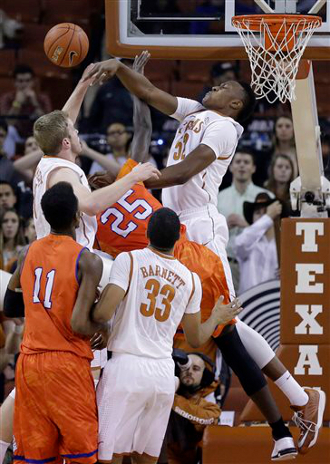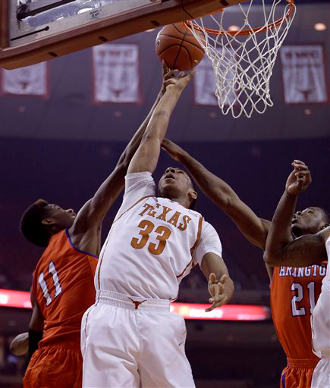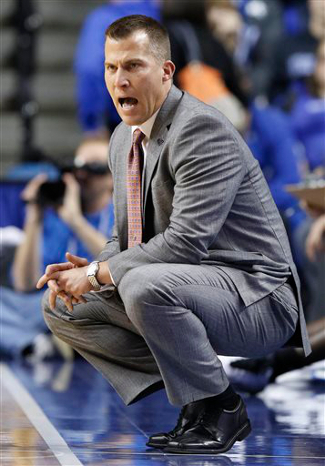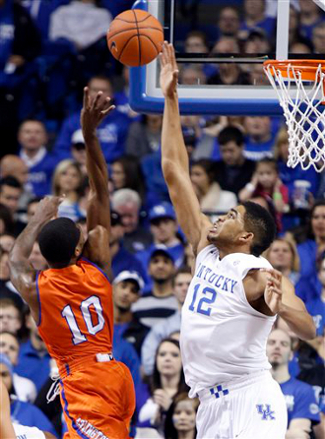It certainly wasn’t pretty, but the Longhorns were able to grind out a victory on Tuesday night against UT Arlington. Texas was ice cold from the floor, made frustrating turnovers throughout the first half, and survived an early three-point barrage from their opponents en route to a 63-53 win. Although the margin was much smaller than the experts had predicted, and even though the Mavs even pulled within three points midway through the second half, this game never felt in doubt. The Longhorns kept UTA at arm’s reach all night, finding ways to nurse their lead throughout the game.
Texas tied a school record for blocked shots It was important for the Longhorns to be able to overcome adversity like they experienced on Tuesday night and still walk away with a win. However, that’s much easier to do against a team like UT Arlington than it would be against a rival in the loaded Big 12, or Friday night against Kentucky, the All-American factory. Bad shooting nights happen, but the Horns were lucky that this one came against a weaker opponent. Even in a Texas win that can be best described as mediocre, we still found seven takeaways to share: 1. Texas wasn’t taking bad shots If you’ve watched the Texas defense suffocate any opponents this season, you know that sometimes low shooting percentages are a result of your opponent making you take tough looks. That wasn’t the case on Tuesday night, as the Longhorns found space and time to fire up shots all game long. UTA was content to pack in their defense and put pressure on the bigs, and more than willing to let Texas try to beat them with jumpers. It was a gambit that paid off, as the Longhorns managed to shoot just 30% from the field, including a 5-of-27 line behind the arc. The Longhorns did seem committed to working the shot clock and being patient in the second half. Often, open looks that may have been tried in the first half were passed up in favor of moving the ball a bit more and seeing what else might open up. Myles Turner also stepped up in the middle, creating trouble for UTA as he fought for space inside. Their defense was clearly overmatched, and the whistles piled up. Of course, shooting percentage will be something to keep an eye on throughout the season. It’s one thing if you just have a bad shooting night and the open looks aren’t falling. It’s another, much more serious problem, if you just always miss your open looks. If the latter ends up being the case for Texas this year, the team will see opponents pack the lane for 40 minutes every night, and it will be very tough to score. 2. Miscues piled up early for the Horns The Longhorns coughed it up nine times in the first half, ending more than 26% of their possessions with a turnover. That bug continued into the second half, with Texas giving it away on four more possessions before the under-16 media timeout. They tightened things up from there, not allowing another turnover for the final 16:27 of the game. On the night, the Longhorns finished with a turnover rate of 22%. In a game where the team shot so poorly, it is impressive that they were also able to make so many mistakes and still win the game. However, this game was part of a troubling trend for Texas in regards to ball control, as it was the third straight outing in which the Longhorns posted a turnover rate north of 21%. That same lack of discipline could make things turn ugly very quickly in Lexington on Friday night. The return of Isaiah Taylor should help with this issue in time for conference play, but it could be a bumpy ride in the meantime. 3. Felix produced in limited minutes With this being the middle game in a six-day, three-game stretch, it was important for the Longhorns to get some rest for their key players. Unfortunately, Texas’s inability to put UTA away made that very difficult, with Demarcus Holland and Jonathan Holmes playing a combined 67 minutes. Thanks to a solid outing from Kendal Yancy, though, Javan Felix was able to play just 20 minutes and rest his legs. In that short appearance, Felix upped his production levels. Early in the game, he made two buckets in catch-and-shoot situations, rather than dominating the ball and firing off the bounce. On the night, he would only make one additional basket, underscoring the fact that Felix’s performance will undoubtedly improve when Taylor is back, and he is able to play off the ball. It should also be noted that it speaks to his reputation as a volume shooter that we’re praising his restraint after a 3-for-8 night. In addition, Felix also logged an assist on one of the team’s few fast-break hoops, as he caught UTA napping in transition and simply pushed it all the way up the court and fed Ridley from the elbow for an easy dunk. It feels like we’ve said it after each of the last three games, but if Felix can focus on judiciously pushing the tempo and only firing in open, catch-and-shoot situations, he will do a much better job as the interim point guard. 4. Ridley is still struggling down low In the first few minutes, the Longhorns made it a point to pound the rock down low, and Cameron Ridley made a quick, strong move with the ball that made it seem like his rough game at UConn was an aberration. As the game wore on, however, the big man once again struggled against double teams. Ridley often froze with the ball as the defensive pressure intensified, rather than quickly moving the ball and making UTA pay for their strategy. Later in the game, Ridley was the recipient of some excellent interior passes, and he managed to use quick footwork and dunk with authority. Fans can only hope that those moves were a result of a discussion at halftime, and that the big man keeps that lesson in mind as he faces a tall, athletic defense on Friday night. Ridley has managed just 17 minutes in each of his last two outings, but the Longhorns will need more than that from him moving forward. The only way he’ll stay on the floor, however, is to think quickly against interior pressure. 5. Turner carried the team to victory One of those great feeds to Ridley came from fellow big man Myles Turner, who logged two assists on the night. Turner shot only 2-of-7 from the field, but frustrated the Mavericks all night, and helped the team grind out a win. His activity in the paint caused numerous defensive fouls away from the ball, and he also was in the mix on a few offensive fouls charged to UTA. Turner snagged 10 rebounds to earn his second career double-double, and led the team with five blocks on a night that the Longhorns tied a school record for swats. With Turner drawing so many fouls and Texas spending most of the game in the bonus, the freshman had to cash in on his freebies at the line. He knocked down 14-of-17 free throws, part of the team’s 81.5% performance at the charity stripe. That puts Turner’s season free-throw average at 83.3%, further ensuring that he will be part of the frontcourt when games get down to crunch time.
Jordan Barnett had trouble finishing at the rim 6. Barnett still needs some seasoning With Barnes trying to give his backcourt some rest, Jordan Barnett saw eight minutes of action, with most of that coming in the first half. He showed off a springy set of legs, and his length is ridiculous, but he was unable to finish inside. With that wingspan and those hops, Barnett will likely be a great rebounder and defender for Texas somewhere down the line, but his point-blank misses indicate that it may take quite some time for him to earn more minutes. 7. The big men stayed grounded A major issue plaguing the Texas bigs this season has been a propensity for biting on shot fakes that either led to dumb fouls or scrambling by the rest of the defense. Last night, the Longhorns stayed on the floor, and they ended up tying a school record for blocks. At the final buzzer, Texas had posted a block percentage of 33.3%, by far the team’s best mark this season, and one that lifted their season-long block percentage to third-best in the country. The defense’s discipline wasn’t solely limited to ignoring fakes, as they worked well as a unit, something that was exemplified by one broken play midway through the first half. When UTA bobbled the ball in the lane, the Longhorns reacted a little slowly as they tried to get to the loose ball, leaving them out of position once the Mavericks recovered. Yancy saw a UTA player drifting into space on the baseline, and slid down to cut off his angle. That quick response gave Texas a few seconds to match back up, and Yancy then raced out to the perimeter to challenge another UTA player who had found space in the scramble. The Mavs took advantage of that late closeout, put the ball on the floor, and then found an open player just outside the lane. Holmes sprang into action to block the shot from behind, then patrolled the paint as UTA won back the missed shot. The big man was there to reject one more UTA attempt, forcing them into a shot-clock violation. The Longhorns reacted quickly throughout that broken play to cover for each other and wipe away their mistakes. Although teams much better than UTA might have been able to take advantage of the little things that went wrong on that possession, the ability for the Longhorns to quickly recover as a unit, even with reserves on the floor, is something that will serve the defense well throughout the season. Next up: at #1/1 Kentucky (7-0); Friday, 6 P.M. CT (ESPN) |













